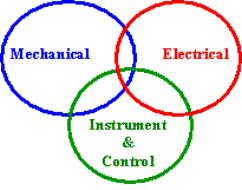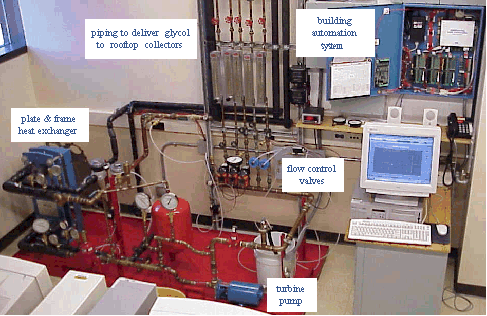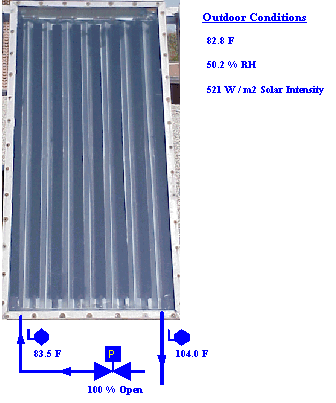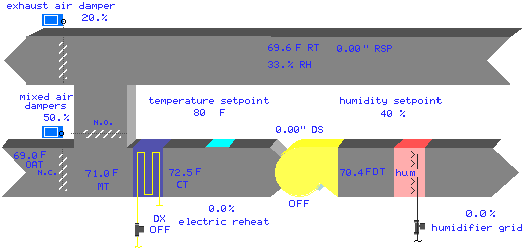AutomatedBuildings.com
|
[an error occurred while processing this directive] |
![]()
![]()
![]()
William J. Hutzel
Abstract - Building Automation is one technical field where lab-based continuing education programs can be delivered in a distance learning format. The widespread use of computer controls for optimizing the efficiency of a building's mechanical and electrical systems has made the "distance" element possible. Rather than traveling to individual buildings to make pressure, temperature, and flow measurements in person, facility engineers routinely access performance data over the Internet. This networking capability has been used in an educational setting at a large university to deliver interactive technical training to large numbers of undergraduate students. Many students can access real time data from a single piece of HVAC equipment over the Internet. This same capability can be adapted to in-house training programs for professional facilities engineers and building automation personnel.
William J. Hutzel is an Associate Professor in the Mechanical Engineering Technology Department at Purdue University, where his areas of expertise include HVAC and controls. He can be reached by phone at (765) 494-7528 or by email at wjhutzel@tech.purdue.edu.
FACILITY ENGINEERS NEED CONTINUING EDUCATION
This paper is an excerpt from a presentation that will be delivered at the International Conference on Engineering Education in Oslo, Norway in August of 2001 [1].
[an error occurred while processing this directive]Facilities engineering is an important technical career in the United States. A long-term boom in commercial and industrial construction has created a strong demand for skilled personnel who oversee the sophisticated mechanical & electrical systems in large buildings. Facility engineers are the "energy managers" who play a crucial role in the long-term success of most commercial and industrial enterprises. This important function has been recently brought into sharper focus by the highly publicized energy shortages in California and elsewhere. Unfortunately, Technology & Engineering programs at universities across the United States are not supplying enough technical personnel to adequately address this problem.
Figure 1 illustrates the technical skills needed by today's facility engineer. Although mechanical and electrical skills are essential, the distinction between the two is becoming obscured by the increased use of instrumentation and computer controls for building management. A facilities engineer with a mechanical background should understand how power quality impacts the performance of mechanical equipment. In contrast, a facilities engineer with an electrical background needs to understand how variable speed fans influence indoor air quality. The demand for multi-skill facility engineers who possess mechanical, electrical, and controls expertise will continue to increase as rising costs make the need for energy efficiency a higher priority.

FIGURE 1.
FACILITIES ENGINEERS NEED A BROAD TECHNICAL BACKGROUND.
It is not surprising that a recent forecasting report by the American Society of Mechanical Engineers (ASME) suggests that facilities engineering will be one of the fastest growing technical careers over the next decade [2]. The same report also documents that access to continuing education is one of the challenges facing both facility engineers and technical educators. Career and family obligations typically prevent facility engineers from attending a course on a university campus. On the other hand, technical educators are usually aware of the latest technical developments in their field but cannot deliver this information to people already in industry. Facilities engineers need to embrace the need for lifelong learning, but technical educators need to make continuing education programs more accessible.
BUILDING AUTOMATION IS A CRUCIAL TOPIC
The Instrument & Control segment of Figure 1 is a glaring weakness for many facility engineers. Although there have been modest improvements to mechanical equipment and electrical distribution systems over the past 20 years, there has been a tremendous revolution in how large commercial buildings are operated and controlled. Since energy costs are usually the biggest part of a building's operating budget significant savings and improved comfort can be achieved by using computers to manage energy use. In the case of a building's mechanical systems, sophisticated computer algorithms save money by modulating heating, cooling, and airflow depending upon the time of day, outdoor conditions, and level of human occupancy.
Despite the importance and widespread use of these building automation systems, many facility engineers lack sufficient instrument & control background to take full advantage of available technology. Control strategies and operating protocols change very rapidly. Solutions that are more than five years old can be obsolete. Professional facility engineers from hospitals, all types of schools, retail facilities, and large apartment buildings desperately need access to convenient and ongoing building automation training, but lack the resources to attend a short course in person.
The good news is that building automation is one technical field where "hands-on" continuing education in a distance learning format has become a viable option. In this unique situation, the core technology provides it's own ready-made solution. Remote access is an integral component of all building automation systems. Rather than traveling to individual buildings to make pressure, temperature, and flow measurements in person, facility engineers routinely access performance data over the Internet. It is a natural extension of this technology to deliver distance education programs that take advantage of the remote access feature.
CREATING A VIRTUAL HVAC LAB
The Mechanical Engineering Technology (MET) Department at Purdue University in West Lafayette, Indiana has made significant progress on developing a state-of-the-art teaching laboratory for facilities engineering, with a particular emphasis on building automation. The Applied Energy Laboratory features a forced air system and a hydronic (water-based) system that demonstrate typical mechanical & electrical equipment used for climate control in commercial buildings. The laboratory also features a variety of roof-mounted solar collectors. A brief overview of two specific laboratory systems should help illustrate the varying degrees of remote access and the opportunities for distance education.
Figure 2 shows some of the laboratory equipment for the lab's solar collectors. A small turbine pump with a variable speed drive regulates the flow of 50% propylene glycol to an array of active loop solar collectors located on the roof of the Knoy Hall of Technology. The plate & frame heat exchanger and flow control valves were specifically selected to represent equipment commonly found in the mechanical rooms of commercial buildings. The solar collector system is fully instrumented with pressure, temperature, and flow sensors for monitoring system performance.
In a typical laboratory experiment, students compare the efficiency of eight different solar collectors [3]. "Efficiency" is a broad term, but in this instance it is defined as the ratio of thermal energy collected to radiant energy available. Thermal energy is determined from temperature and flow measurements. Radiant energy is measured directly by a roof-mounted solar pyranometer.
From an educational perspective, the most intriguing aspect of this basic solar energy experiment is that the entire project can be completed over the Internet. The data shown in Figure 3 was collected without visiting the West Lafayette campus in person. On a sunny day in May of 2001 the outdoor air temperature was 83 °F and the relative humidity was 50%. Under these conditions the fluid temperature entering and leaving the collector was 83 °F and 104 °F respectively. The climatic conditions and thermal performance are not the primary focus here. The key point is that a building automation system allows a large number of simultaneous users to access real time performance data.

FIGURE 2.
BUILDING AUTOMATION SYSTEMS MONITOR & CONTROL MECHANICAL EQUIPMENT.

FIGURE 3.
SOLAR COLLECTOR DATA IS ACCESSED OVER THE INTERNET USING A PROPRIETARY GRAPHIC
INTERFACE.
This "virtual" solar energy equipment has been used by a large number of students in Purdue University's Mechanical Engineering Technology Department, which operates from seven different locations across Indiana. Rather than functioning autonomously, the programs cooperate to provide a high quality technology education that is readily accessible from almost anywhere in the state. The backbone of the statewide technology program is that the same lectures and lab experiments are replicated at each site. A thermodynamics course taught in West Lafayette, Indiana is the same as one taught hundreds of miles away at Elkhart, Columbus, Muncie, Richmond, New Albany, or Kokomo.
Maintaining continuity between the different MET programs is an ongoing challenge. The MET program at West Lafayette has the most students and the most extensive laboratory facilities. Although the six smaller MET programs at the other statewide locations do not have the resources to duplicate the solar energy equipment at West Lafayette, technology allows us to share! During the 2001-2002 academic year, approximately 200 MET students enrolled in thermodynamics at seven different locations across the state of Indiana will use the Internet to evaluate the efficiency of solar collectors that are physically located on the West Lafayette campus.
There is one significant drawback to the virtual solar energy equipment. A proprietary graphic user interface must be installed on each personal computer that accesses the solar collectors. The software is simple to install and run, but problems occur whenever updates are made. Each update must be distributed and manually installed on all remote personal computers. This approach can be cumbersome and inconvenient when frequent changes are made. As an example, two minor typographical errors were recently discovered on the graphic user interface for the solar collectors. To make the full correction, a new version of the graphic interface had to be distributed and installed on all personal computers used by MET statewide technology programs.
Figure 4 shows the graphic interface for the lab's forced air system that displays a variety of real-time temperature, pressure, and humidity readings. Outside air enters the system from the lower left, where it is mixed with re-circulated air before being cooled, heated, or humidified in the air handler. A fan with a variable speed drive provides the pressure differential to pull air through the system. As with the solar collector equipment, the real-time data shown in Figure 4 is accessed over an Internet connection.

FIGURE 4.
FORCED AIR DATA IS ACCESSED FROM A WEB PAGE.
A new and innovative approach to Internet-based control will soon make it easier to access the forced air system from any remote location. The new graphic user interface is a java-based program that will reside on a web server within the Knoy Hall of Technology. The building automation panel and web server talk back and forth. Temperature, pressure, and flow readings are broadcast to the web server at regular intervals. The beauty of this strategy is that communication has become as simple as surfing the web. When this system is fully operational, anyone with the correct password and a standard Internet browser, such as Windows Explorer or Netscape, can interact with the forced air system. This new system should be available by the end of 2001. Another key advantage of the web-based approach is that all data on the forced air system is housed in one central location. When changes to the graphics or the control program are made, they are instantly available to anyone who uses the system. Unlike the solar collector equipment, there is no need to manually distribute software updates.
DISTANCE EDUCATION
The virtual HVAC laboratory is not intended exclusively for full-time undergraduate students. It will also help meet the continuing education needs of facility engineers. It has the unique ability to deliver "hands-on" technical training to practicing facility engineers in a convenient format. Rather than having a group of adult learners travel to a university or community college, a single instructor can visit their place of employment. As long as personal computers with Internet access are available, traditional classroom lectures can be supplemented by laboratory exercises featuring Internet-based HVAC equipment.
The interactive laboratory-based component will be crucial for illustrating sophisticated energy conservation strategies. It's one thing to describe how a "temperature reset" control algorithm operates, and quite another to demonstrate the common pitfalls of implementing this protocol on a typical air handler. All building automation systems store several days' worth of performance data. A trend of temperature data, plotted with respect to time, can graphically illustrate how the temperature reset algorithm automatically adjusts air temperature to minimize energy consumption.
REFERENCES
[1] Hutzel, W.J. "Creating a Virtual Laboratory for HVAC Continuing/Distance Education", Proceedings of the 2001 International Conference on Engineering Education, Oslo, Norway.
[2] "Mechanical Engineering in the 21st Century: Trends Impacting the Profession", American Society of Mechanical Engineers, 1999.
[3] Hutzel, W.J. "Energy Conservation in Thermal Power Courses", Proceedings of the 2001 ASEE Annual Conference & Exposition, Albuquerque, NM.
[an error occurred while processing this directive]
[Click Banner To Learn More]
[Home Page] [The Automator] [About] [Subscribe ] [Contact Us]